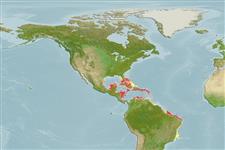Common names from other countries
Environment: milieu / climate zone / depth range / distribution range
Ökologie
seewasser riff-verbunden; tiefenbereich 5 - 20 m (Ref. 9710). Tropical
Western Central Atlantic: Florida (USA), Bahamas, Puerto Rico, Grand Cayman Island, Virgin Islands, Antigua, Barbados, Aruba, Curaçao, Colombia, and Venezuela.
Size / Gewicht / Alter
Maturity: Lm ? range ? - ? cm
Max length : 8.5 cm TL Männchen/unbestimmt; (Ref. 7251)
Rückenflossenstacheln (insgesamt) : 18 - 21; Rückenflossenweichstrahlen (insgesamt) : 31 - 36; Afterflossenstacheln: 2; Afterflossenweichstrahlen: 33 - 37. Light brown with pale dots and a narrow mid-lateral brown stripe, sometimes broken into blotches; faint bars on body; small black spot at front of dorsal fin; mature males with more yellow on head, gill membranes black; branchiostegal rays blue (Ref. 13442).
Occurs in groups, one to a hole, in limestone or coral rubble in clear water. Feeds on small crustaceans, worms, and fishes (Ref. 5521).
Life cycle and mating behavior
Maturities | Fortpflanzung | Spawnings | Egg(s) | Fecundities | Larven
Robins, C.R. and G.C. Ray, 1986. A field guide to Atlantic coast fishes of North America. Houghton Mifflin Company, Boston, U.S.A. 354 p. (Ref. 7251)
IUCN Rote Liste Status (Ref. 130435)
CITES (Ref. 128078)
Not Evaluated
Bedrohung für Menschen
Harmless
Nutzung durch Menschen
Fischereien: kommerziell; Aquarium: Kommerziell
Tools
Zusatzinformationen
Download XML
Internet Quellen
Estimates based on models
Preferred temperature (Ref.
115969): 26.4 - 28.2, mean 27.5 (based on 520 cells).
Phylogenetic diversity index (Ref.
82804): PD
50 = 0.5010 [Uniqueness, from 0.5 = low to 2.0 = high].
Bayesian length-weight: a=0.00457 (0.00183 - 0.01143), b=3.08 (2.86 - 3.30), in cm Total Length, based on LWR estimates for this (Sub)family-body shape (Ref.
93245).
Trophic level (Ref.
69278): 3.7 ±0.55 se; based on food items.
Fishing Vulnerability (Ref.
59153): Low vulnerability (10 of 100).
